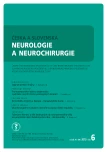Failure of Intraoperative Indocyanine Green (ICG) Videoangiography to Detect a Clip Occlusion of an Aneurysm – a Case Report
Authors:
V. Přibáň 1; I. Holečková 1; J. Mraček 1; V. Runt 1; D. Štěpánek 1; F. Šlauf 2
Authors‘ workplace:
LF UK a FN Plzeň
Neurochirurgické oddělení
1; LF UK a FN Plzeň
Klinika zobrazovacích metod
2
Published in:
Cesk Slov Neurol N 2013; 76/109(6): 773-778
Category:
Case Report
Overview
Intraoperative indocyanine green (ICG) videoangiography is now widely used in aneurysm surgery because of its reliability and safety. ICG videoangiography is able to evaluate patency of parent, branching and perforating arteries and documents clip occlusion of aneurysms. False interpretation of ICG videoangiography may occur when viewing aneurysms and arteries located deep in the visual field. The authors present a case of unruptured large left middle cerebral artery aneurysm in a 65-year-old woman in whom ICG videoangiography wrongly displayed clip occlusion of the aneurysm. ICG videoangiography confirmed blood flow in parent, branching and perforating arteries, the sac behind the clip did not fill with contrast. Fundus puncture caused bleeding and, consequently, contrast material occurred in the sac. We added more clips (totalling five) and we succeeded to stem the inflow of blood into the sac. The authors emphasize the need for opening the sac after clipping. Full reliance on ICG videoangiography could lead to erroneous aneurysm treatment with an uncertain long‑term result.
Key words:
intracranial aneurysms – clipping – indocyanine green – videoangiography
The authors declare they have no potential conflicts of interest concerning drugs, products, or services used in the study.
The Editorial Board declares that the manuscript met the ICMJE “uniform requirements” for biomedical papers.
Sources
1. Yasargil MG. Microneurosurgery. Vol. II. Stuttgart. New York: Georg Thieme Verlag 1984.
2. Raabe A, Beck, J, Gerlach R, Zimmermann M, Seifert V. Near ‑ infrared indocyanine green video angiography: a new method for intraoperative assessment of vascular flow. Neurosurgery 2003; 52(1): 132 – 139.
3. Raabe A, Nakaji P, Beck J, Kim LJ, Hsu FPK, Kamerman JD et al. Prospective evaluation of surgical microscope ‑ integrated intraoperative near ‑ infrared indocyanine green videoangiography during aneurysm surgery. J Neurosurg 2005; 103(6): 982 – 989.
4. Mery FJ, Amin‑Hanjani S, Charbel FT. Is angiographically obliterated aneurysm always secure? Neurosurgery 2008; 62(4): 979 – 982.
5. Feuerberg I, Lindquist C, Lindquist M, Steiner L. Natural history of postoperative aneurysm rest. J Neurosurg 1987; 66(1): 30 – 34.
6. Macdonald RL, Wallace MC, Kestle JR. Role of angiography following aneurysm surgery. J Neurosurg 1993; 79(6): 826 – 832.
7. Meyer B, Urbach H, Schaller C, Baslam M, Nordblom J, Schramm J. Immediate postoperative angiography after aneurysm clipping – implications for quality control and guidance of further management. Zentralbl Neurochir 2004; 65(2): 49 – 56.
8. Thorton J, Bashir Q, Aletich VA, Debrun GM, Ausmann JI, Charbel FT. What percentage of surgically clipped intracranial aneurysms have residual necks? Neurosurgery 2000; 46(6): 1294 – 1300.
9. Dashti R, Laakso A., Niemelä M, Porras M, Hernesniemi J. Microscope ‑ integrated near ‑ infrared indocyanine green videoangiography during surgery of intracranial aneurysms: the Helsinki experience. Surg Neurol 2009; 71(5): 543 – 550.
10. Snyder LA, Spetzler RF. Current indications for indocyanine green angiography. World Neurosurg 2011; 76(5): 405 – 406.
11. Balamurugan S, Agrawai A, Kato Y, Sano H. Intraoperative indocyanine green video‑angiography in cerebrovascular surgery: An overview with review of literature. Asian J Neurosurg 2011; 6(2): 88 – 93.
12. Murai Y, Adachi K, Matano F, Tateyama K, Teramoto A. Indocyanine green videoangiography study of hemangioblastomas. Can J Neurol Sci 2011; 38(1): 41 – 47.
13. Oda J, Kato Y, Chen SF, Sodhiya P, Watabe T, Imizu S et al. Intraoperative near ‑ infrared indocyanine green ‑ videoangiography (ICG ‑ VA) and graphic analysis of fluorescence intensity in cerebral aneurysm surgery. J Clin Neurosci 2011; 18(8): 1097 – 1100.
14. Nishiyama Y, Kinouchi H, Senbokuya N, Kato T, Kanemaru K, Yoshioka H et al. Endscopic indocyanine green video angiography in aneurysm surgery: an innovative method for intraoperative assessment of blood flow in vasculatuer hidden from microscopic view. J Neurosurg 2012; 117(2): 302 – 308.
15. Komotar RJ, Mocco J, Lavine SD, Solomon RA. Angiographically occult, progressively expanding, giant vertebral artery aneurysm. J Neurosurg 2006; 105(3): 468 – 471.
Labels
Paediatric neurology Neurosurgery NeurologyArticle was published in
Czech and Slovak Neurology and Neurosurgery

2013 Issue 6
Most read in this issue
- Frontotemporal Lobar Degeneration from the Perspective of the New Clinical‑ Pathological Correlations
- Tuberous Sclerosis Complex in Children Followed from Neonatal Period for Prenatally Diagnosed Cardiac Rhabdomyoma – Two Case Reports
- Pineal Region Expansions
- Occipital Condyle Fractures
